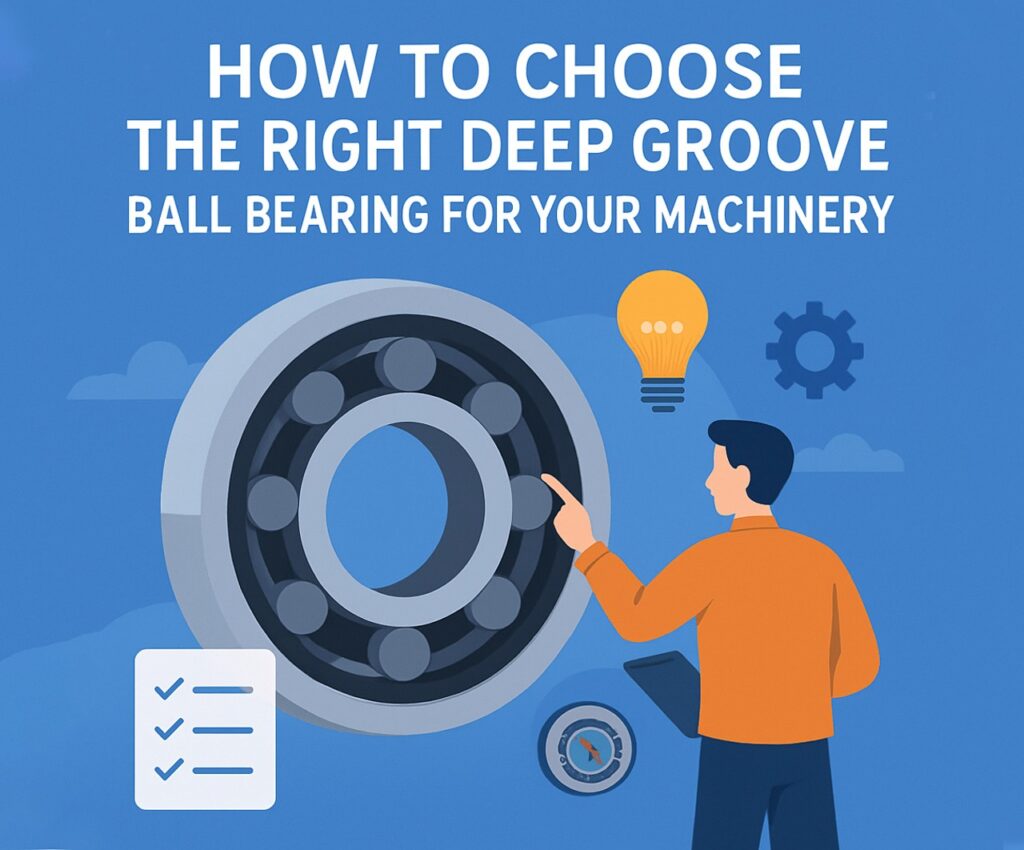Choosing the right axial right deep groove ball bearing, deep ball groove bearing, or deep groove ball is critical to ensuring the longevity, efficiency, and reliability of your machinery. Whether you’re upgrading existing systems or designing new equipment, understanding how to select the proper bearing will reduce maintenance downtime and prevent unexpected failures. In this guide, we’ll break down everything you need to know to make the right decision for your specific application. Know More
1. Understand the Function and Load Type
Start by identifying what function the bearing will serve. A deep groove ball typically handles radial loads, but many types are designed to support axial loads too. If your machinery involves both radial and axial forces, an axial deep groove ball bearing is often the best fit. It allows for smoother movement in both directions without compromising stability.
Understanding whether your equipment applies more radial, axial, or combined loads will help narrow your options. For example, conveyor belts may need more radial support, while vertical shaft applications lean on axial capacity. Always align the deep ball groove bearing type with your machinery’s operational dynamics.
2. Know Your Speed Requirements
Each deep groove ball comes with a maximum speed rating. Exceeding this limit can cause overheating and lead to premature wear or catastrophic failure. High-speed applications like turbines or automated production lines demand precision-manufactured bearings. In contrast, slower-moving parts can rely on standard-speed models without issue.
Choosing a bearing rated for your specific RPMs also affects lubrication needs and heat dissipation. Manufacturers typically list these limits in their product datasheets. Always select a deep ball groove bearing that comfortably operates within your system’s speed range.
3. Material Matters
The most common materials used in deep groove ball manufacturing are stainless steel and chrome steel. Stainless steel offers better corrosion resistance, ideal for food processing or chemical exposure. Chrome steel provides strength and hardness, which suits industrial machines.
For special use cases, consider hybrid options that include ceramic balls. These are lighter, generate less heat, and last longer. While more expensive, hybrid axial deep groove ball bearing units are perfect for high-precision or cleanroom environments.
4. Consider the Bearing Clearance
Clearance refers to the internal gap between the balls and the raceways. Too much clearance, and the bearing becomes unstable; too little, and it may bind under thermal expansion. Bearings come with predefined clearances like C2 (tight) to C5 (loose).
Choosing the right clearance for your deep groove ball ensures smooth performance under your machine’s specific conditions. If you’re operating at high temperatures, opt for a looser clearance to allow for thermal expansion.
5. Seals and Shields: Do You Need Them?
Bearings come in open, shielded, or sealed variations. Sealed bearings are maintenance-free and keep contaminants out, which is crucial in dirty or wet environments. Shielded options offer some protection while allowing higher RPMs.
For machinery in dusty, corrosive, or humid conditions, a sealed deep ball groove bearing is often the best choice. But if you require more speed and can maintain a clean environment, shielded or open designs may be better.
6. Precision Grades: How Accurate Does It Need to Be?
Precision is a significant factor in choosing a deep groove ball. Bearings are graded by tolerance levels—ABEC (Annular Bearing Engineers’ Committee) ratings range from 1 to 9, with 9 being the most precise.
For general machinery, ABEC 1 or 3 is usually sufficient. High-speed spindles or medical devices might require ABEC 7 or higher. Over-specifying increases costs without tangible benefits, so match the precision to your performance needs.
7. Lubrication: Pre-lubricated or Manual?
Pre-lubricated bearings reduce installation time and maintenance. They’re perfect for hard-to-access components where manual greasing isn’t practical. However, manually lubricated axial deep groove ball bearing units offer more control over lubrication types and intervals.
Your choice depends on how your system operates. For heavy-duty or high-temperature settings, choose bearings that allow for custom lubrication schedules.
8. Load Life and Durability Ratings
All deep ball groove bearing products come with expected life cycle ratings, typically expressed in L10 hours. This rating predicts the number of hours 90% of the bearings will operate without failure. Choose a bearing with a life rating well beyond your expected operating time to ensure long-term reliability.
Don’t forget to factor in the safety margin—unexpected loads, misalignment, or temperature spikes can reduce actual lifespan.
9. Mounting Configuration and Fit
Bearings must match the shaft and housing with the right interference fit. Too tight, and installation becomes difficult; too loose, and you risk shaft movement or vibration. Match the fit class of your deep groove ball with the manufacturer’s installation guidelines.
Improper mounting can lead to premature failure even if you’ve selected the perfect bearing type. Use the correct tools and follow torque specifications to ensure a secure setup.
10. Supplier Reliability and Certification
Even the best-designed bearing won’t perform if it’s poorly manufactured. Always choose deep ball groove bearing suppliers with ISO 9001 certification or better. Check for documented quality control, material sourcing, and performance testing.
Partnering with a reputable supplier also ensures you get support for installation, replacement, and troubleshooting.
11. Think About the Operating Environment
Harsh environments need tougher bearings. If your machinery is exposed to saltwater, extreme temperatures, or chemicals, make sure your axial deep groove ball bearing has the right protective coatings or materials. Special seals, greases, and heat treatments can extend the life of your bearing in these conditions.
Look for products specifically rated for your environment to avoid unplanned downtime.
12. Consider Cost vs. Value
A cheaper deep groove ball might save upfront, but higher-quality bearings reduce maintenance, downtime, and replacements. Consider the total cost of ownership (TCO), not just the sticker price.
Invest in bearings that are tested and proven in similar industrial settings. The peace of mind and long-term savings usually outweigh the initial costs.
Final Thoughts
Selecting the right deep ball groove bearing, axial deep groove ball bearing, or deep groove ball goes beyond just matching size and load. It’s about understanding your machinery, environment, and performance requirements. Consider speed, load, materials, precision, lubrication, and durability. Then choose a trusted supplier that meets your specific application standards.
By following these 12 guidelines, you can ensure your machinery runs smoother, lasts longer, and stays efficient—without costly breakdowns or surprise repairs.

